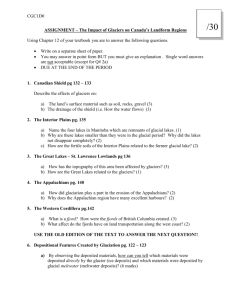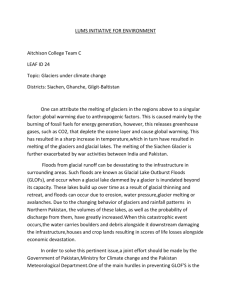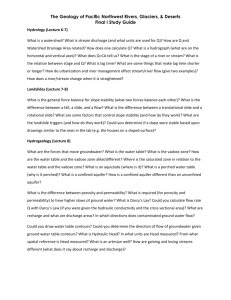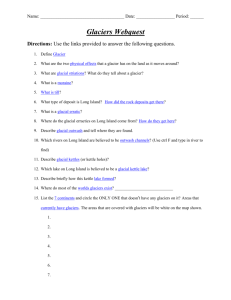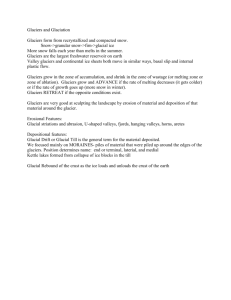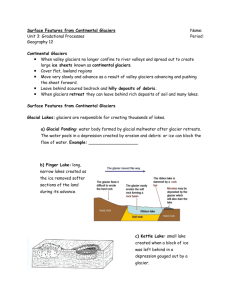Inventory of glaciers and glacial lakes and the identification of
advertisement
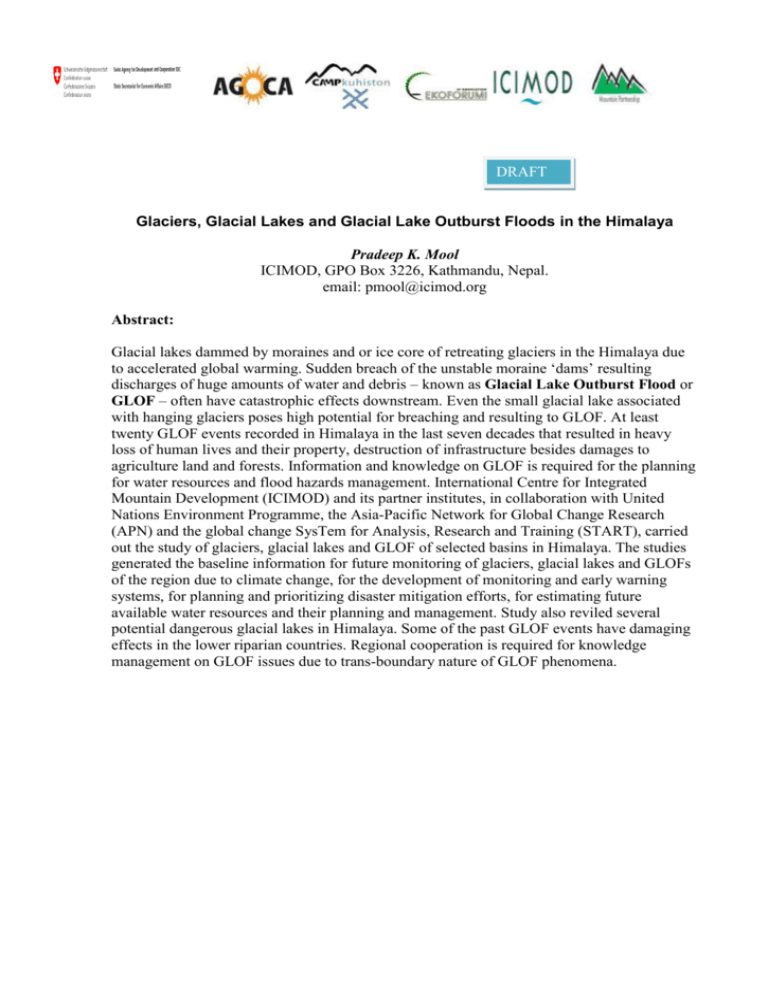
DRAFT Glaciers, Glacial Lakes and Glacial Lake Outburst Floods in the Himalaya Pradeep K. Mool ICIMOD, GPO Box 3226, Kathmandu, Nepal. email: pmool@icimod.org Abstract: Glacial lakes dammed by moraines and or ice core of retreating glaciers in the Himalaya due to accelerated global warming. Sudden breach of the unstable moraine ‘dams’ resulting discharges of huge amounts of water and debris – known as Glacial Lake Outburst Flood or GLOF – often have catastrophic effects downstream. Even the small glacial lake associated with hanging glaciers poses high potential for breaching and resulting to GLOF. At least twenty GLOF events recorded in Himalaya in the last seven decades that resulted in heavy loss of human lives and their property, destruction of infrastructure besides damages to agriculture land and forests. Information and knowledge on GLOF is required for the planning for water resources and flood hazards management. International Centre for Integrated Mountain Development (ICIMOD) and its partner institutes, in collaboration with United Nations Environment Programme, the Asia-Pacific Network for Global Change Research (APN) and the global change SysTem for Analysis, Research and Training (START), carried out the study of glaciers, glacial lakes and GLOF of selected basins in Himalaya. The studies generated the baseline information for future monitoring of glaciers, glacial lakes and GLOFs of the region due to climate change, for the development of monitoring and early warning systems, for planning and prioritizing disaster mitigation efforts, for estimating future available water resources and their planning and management. Study also reviled several potential dangerous glacial lakes in Himalaya. Some of the past GLOF events have damaging effects in the lower riparian countries. Regional cooperation is required for knowledge management on GLOF issues due to trans-boundary nature of GLOF phenomena. Glaciers are nature’s valuable source of fresh water in the form of frozen reservoirs from which large amounts of melt ice release to many of the major rivers of the Hindu Kush– Himalaya (HKH) (Xu Jianchu et.al. 2007; Zemp, M., et. al., 2007). They supply water for drinking, and the needs of agriculture, hydropower, and industry for the millions of people living downstream. Glaciers are also repositories of information for exploring quaternary climate changes, as they remain sensitive to global temperature conditions. This is indicated by the continuous retreat of glaciers, and the formation of many glacial lakes at the toe of glaciers dammed by the loose moraine. The rapid accumulation of water in glacial lakes can lead to a sudden breach of their unstable moraine dams, however. The resultant discharges of huge amounts of water and debris – a glacial lake outburst flood – often have catastrophic effects downstream. A number of glacial lake outburst floods (GLOFs) have been reported in the region in the last few decades, particularly from the eastern sector of the region. GLOFs have resulted in many deaths for downstream populations as well as destruction of property and infrastructure. Climate change due to the enhanced greenhouse effect has increased the rate of glacier melting and thereby the frequency of GLOFs in recent years. Since industrialization, human activities have resulted in steadily increasing concentrations of greenhouse gases in the atmosphere, leading to fears of enhanced greenhouse effect. The world’s average surface temperature has increased between 0.3 and 0.6oC over the past hundred years. The Intergovernmental Panel on Climate Change (IPCC), in its third assessment report, revealed that the rate and duration of the warming in the 20th century is larger than at any other time during the last one thousand years. The 1990s was likely to be the warmest decade of the millennium in the Northern Hemisphere, and the year 1998, the warmest year (IPCC, 2001a). According to the World Meteorological Organization (WMO), year 2002 and 2003 have been the 2nd and 3rd hottest years, respectively ever since climate statistics have been monitored and documented. Climate change is causing the net shrinkage and retreat of glaciers and the increase in size and number of glacial lakes, especially in the high mountains. Studies using satellite data have tried to correlate present area under glaciers with historical records, and with fluctuations in temperature. Results show that the recession rate has increased with rising temperature. For example, with the temperatures rising by 1oC, Alpine glaciers have shrunk by 40% in area and by more than 50% in volume since 1850 (IPCC, 2001b & CSE, 2002). Evidence also show that the changes in temperature are more pronounced at higher altitudes. Analysis of air temperature trends across 49 stations in Nepal between 1977-1994, for example, revealed a clearly rising trend, with the change much more pronounced in the higher altitude regions of the country. (Shrestha et al. 1999) This has a twofold impact on the mass balance of glaciers. The direct result is to accelerate their melting. Furthermore, it induces precipitation to occur in liquid instead of solid form, even at very high altitudes. The absence of a blanketing layer of snow on the ice lowers its albedo, making glaciers further prone to radiative melting (Mool, P.K et al, 2001a). Numerous studies carried out during 1999-2001 lend credence to the link between climate change and glacier melting. All the glaciers in the Himalaya have retreated by approximately a kilometer since the Little Ice Age [AD 1550-1850] (Mool P.K et al,2001a). The Dokriani Bamak Glacier in the Himalaya (India) retreated by 20 meters in 1998, compared to an average retreat of 16.5 meters over the previous five years. (Matny, L., 2000). A long-term study entitled, ‘The Chinese Glacier Inventory’, by the Chinese Academy of Sciences has ______________________________________________________________________________________________________ “Glaciers, Glacial Lakes and Glacial Lake Outburst Floods in the Himalaya” Pradeep K. Mool Page 2 reported that during the last 24 years there has been a 5.5 % shrinkage in volume of China’s 46,928 glaciers, equivalent to the loss of more than 3000 sq km of ice. The study predicts that if climate continues to change at the present rate, two-thirds of China’s glaciers would disappear by 2050, and almost all would be gone by 2100 (China Daily, 23 September 2004). Evidence have been conclusive enough to make glacier melting and retreat an important indicator for climate change. Table 1: Some recorded GLOF events in Nepal, Tibet Autonomous Region of China and Bhutan No Date Lake 1 Aug-35 Tara-Cho 2 21-Sep-64 Gelhaipco 3 1964 Zhangzangbo 4 25-Aug-64 Longda 5 1968 Ayaco 6 1969 Ayaco 7 18-Aug-70 Ayaco 8 3-Sep-77 Nare 9 23-Jun-80 Nagma Pokhari River Basin Source Country Effected Cause of GLOF Tibet (China) China and Nepal Dam Piping Tibet (China) China and Nepal Glacier surge Tibet (China) China and Nepal Piping Tibet (China) China and Nepal Not known Tibet (China) China and Nepal Not known Tibet (China) China and Nepal Not known Tibet (China) China and Nepal Not known Dudh Koshi Nepal Nepal Moraine collapse Tamor Nepal Nepal Moraine collapse Tibet (China) China and Nepal Glacier surge Tibet (China) China and Nepal Glacier surge Boqu (Tibet) / Sun Koshi (Nepal) PumQu (Tibet) / Arun (Nepal) Boqu (Tibet) / Sun Koshi (Nepal) Gyrong (Tibet) / Trisuli (Nepal) PumQu (Tibet) / Arun (Nepal) PumQu (Tibet) / Arun (Nepal) PumQu (Tibet) / Arun (Nepal) Boqu (Tibet) / Sun Koshi (Nepal) PumQu (Tibet) / Arun (Nepal) 10 11-Jul-81 Zhangzangbo 11 27-Aug-82 Jinco 12 4-Aug-85 Dig Tsho Dudh Koshi Nepal Nepal Ice avalanche 13 12-Jul-91 Chubung Tama Koshi Nepal Nepal Moraine collapse 14 3-Sep-98 TamPokhari Dudh Koshi Nepal Nepal Ice avalanche Tibet (China) China Ice avalanche 15 10-Jul-40 Qunbixiama-Cho KangboquAhmchu 16 10-Jul-54 Sangwang-Cho Nianchu Tibet (China) China Glacier advance 17 26-Sep-64 Damenlahe-Cho Nyang Tibet (China) China Ice avalanche 18 23-Jul-72 Poge-Cho Xibaxiaqu Tibet (China) China Ice avalanche Tibet (China) China Ice avalanche 19 24-Jun-81 Zari-Cho Yarlung Zangbo 20 14-Jul-88 Mitui-Cho Palong Zangbo Tibet (China) China Ice avalanche 21 7-Oct-94 Lugge-Tsho Pho Chu Bhutan Bhutan Moraine collapse 22 15-Aug-03 Kabache Lake Madi River Nepal Nepal Moraine collapse 23 8-Aug-04 Kabache Lake Madi River Nepal Nepal Moraine collapse Some of the glacial lakes in China in Poiqu basin, which is trans-boundary basin and join with SunKoshi-BhoteKoshi in Nepal, such as LumuChimi lake and GangxiCo lake have grown almost double in size within last twentyfive years. These lakes pose potential threat of GLOFs which most often have devastating effects on local people and the surrounding environment. While human activities cause climate change, and climate change accelerates glacier melting and GLOFs, GLOFs in turn cause widespread damage in the human and natural systems. Glacier melting and GLOFs exacerbate land degradation, increase variations in the ______________________________________________________________________________________________________ “Glaciers, Glacial Lakes and Glacial Lake Outburst Floods in the Himalaya” Pradeep K. Mool Page 3 hydrological regime, degrade biodiversity, and trigger many socioeconomic externalities. Climate change will thus intensify and accelerate these impacts and further burden the human and natural systems over a wide area, far beyond the mountain ecosystem. Hence apart from adapting to GLOFs, a long term solution to the impacts of glacier melting and GLOF events is to promote adaptation and mitigation strategies for climate change. GLOFs will increase land degradation through vertical and lateral channel erosion, and the undercutting of colluvial deposits with further downstream transport and aggradations. It has the potential to destabilise talus slopes and to initiate new debris flows and landslides (Bajracharya, S.R., et.al, 2007). These processes leave a long stretch of unstable slope sections with broken vegetation cover. Further downstream, where the channel gradient tapers off, aggradations dominate degradation. The valleys affected by GLOFs will have unusually high loads of sediment deposit (Ives, J.D.1986). Past GLOFs have shown transboundary damaging effects downstream. The socioeconomic impacts of GLOFs could be loss of lives, damage to hydropower facilities, roads, bridges, trekking trails, whole villages, and agricultural lands. Both small and large hydro power infrastructure could be affected by a combination of variable flows, flooding risks, increased sedimentation, and increased monsoon precipitation caused by GLOFs. This could destroy, damage, clog and derate the hydropower infrastructure in risk areas. In recent years, GLOFs have happened in the Himalayan region. A list of GLOF events that have occurred in the region and associated damages caused are given in table 1. The most significant GLOF event since detailed recording started, occurred in Dig Tsho lake at Bhote Kosi in Nepal in 1985. It destroyed a nearly completed small hydropower project (estimated cost of US$ 1.5 million), numerous foot-bridges, trekking trails and caused loss of many lives (P. K. Mool, 1993). A huge rapid landslide dammed the Yigong river (China) on 9 April 2000. After two months, on 10 June 2000, the outburst flood from the landslide dam extended 500 km downstream uptil the state of Arunachal Pradesh, North-Eastern India causing heavy damages (Zhu and Li, 2001). In June 2005, outburst of landslide dam lake on Parechu river (China) caused a transboundary flood in Himachal Pradesh (India). Glaciers thus determine and limit socioeconomic activity to some extent and indicate global climate change. Knowledge of this resource seems an outstanding requirement for future planning of water resources and mitigation of GLOF hazards. The International Centre for Integrated Mountain Development (ICIMOD) and its partner institutes, in collaboration with United Nations Environment Programme /Regional Resource Centre for Asia and the Pacific (UNEP/RRC-AP) carried out a systematic inventory of glaciers and glacial lakes of Nepal and Bhutan in 1999–2001. Later, the study was continued in collaboration with the Asia-Pacific Network for Global Change Research (APN) and the global change SysTem for Analysis, Research and Training (START), and expanded to all the ten sub-basins of the Indus River in Pakistan, all sub-basins of the Ganges in the Tibet Autonomous Region of the Peoples’ Republic of China, and Tista River Basin along Himachal Pradesh Himalaya and Uttaranchal Himalaya of India (http://www.icimodgis.net/glof/glof.php). Once the study on Arunanchal Pradesh Himalaya and Jammu & Kashmir Himalayas, northern Afghanistan and Myanmar area are completed, the entire database of the Hindu Kush–Himalayan region will be served at the scale of 1:50,000. ______________________________________________________________________________________________________ “Glaciers, Glacial Lakes and Glacial Lake Outburst Floods in the Himalaya” Pradeep K. Mool Page 4 Figure: Map of the Hindu Kush-Himalaya showing the areas covered by the Inventory of Glaciers and Glacial Lakes Studies Table 2: Summary of glaciers and glacial lakes in the mountains of Pakistan, India, and China/Tibet Autonomous Region compiled by ICIMOD. Glaciers Glacial Lakes River Basins Total number Area (km2) Total number Area (km2) Pakistan Himalaya Indus Basin 5218 15040.7 2420 126.35 Himachal Pradesh 2554 4160.58 229 379.72 Uttaranchal 1439 4060.04 127 2.49 Tista River 285 576.51 266 20.20 India Himalaya The main objective of the study is to link priority topics in the research framework by identifying the formation of dangerous glacial lakes in the region as a result of global climate change, with direct impacts on terrestrial change and human vulnerability and adaptation. The results and database generated Sub-basins of Ganges 1578 2864.33 824 85.19 from the present studies provide the Nepal Himalaya 3252 5323.89 2323 75.70 baseline information on the region for the Bhutan Himalaya 677 1316.71 2674 106.87 development of monitoring and early Within the study area 15003 33342.76 8863 796.52 warning systems, and for planning and prioritizing disaster mitigation efforts. In addition, the study is anticipated to help lay down the planning guidelines for infrastructure and development and water resources and land-use in the region and in the individual countries of the HKH. Along with information on climate change and future monitoring of glaciers, glacial lakes and GLOFs, this database can provide the basis for estimating future available water resources and their planning and management. Tibet Autonomous Region of the Peoples’ Republic of China A summary of the inventoried glaciers and glacial lakes in the Himalaya of Pakistan, India, Tibet Autonomous Region (People’s Republic of China), Nepal, and Bhutan is given in Table ______________________________________________________________________________________________________ “Glaciers, Glacial Lakes and Glacial Lake Outburst Floods in the Himalaya” Pradeep K. Mool Page 5 2. The database indicates that the number of glacial lakes and glacial lake outburst floods in the eastern Himalaya is comparatively higher than in the western Himalaya. Regular assessment monitoring of glaciers and glacial lakes and adaptation measures including engineering structure and policy linkage for potential dangerous glacial lakes are required. Field validation of these glaciers and glacial lakes are also needed. Advanced scientific knowledge of potential GLOF hazards, building capacity among local institutions and agencies for undertaking or monitoring these studies, and linking this knowledge to policy and planning are, therefore, of immense importance to the lives of millions of mountain dwellers and their downstream neighbors (http://dev.icimod.org/elibrary/index.php/search/publication/169 http://books.icimod.org/index.php/search/publication/131 http://books.icimod.org/index.php/search/publication/286 http://ekh.unep.org/m-eKH/GLOF_NEPAL/GUIDE/movie.html http://www.rrcap.unep.org/issues/glof/glof/index.htm) International Centre for Integrated Mountain Development (ICIMOD) is undertaking several projects on study of glacial lakes and glaciers in the region. ICIMOD with support of the World Bank and in collaboration with partners from Nepal is implementing the project entitled “GLOF Assessment and Mitigation Study of Potential Glacial Lake Outburst Flood (GLOF) lakes in Nepal” from September 2008. The objectives of the study project are (1) to develop recommendations for adaptation and mitigation against GLOF hazards against potential dangerous glacial lakes in Nepal, and (2) to assist Nepal in the development of an overall strategy on how to address risk from GLOF s in the future. ICIMOD is also implementing since 2008 for three year Sida funded project “Too much Water, Too little water- Adaptation strategies to climate induced water stress and hazards in the Greater Himalayan region”. Among the four major activities of the project, the first activity is to strengthen the capacity within ICIMOD, and its national partners, to undertake regular monitoring of glaciers, snow and ice fields, and pro-glacial lakes, on a regional scale, with the purpose of supporting researchers and policy and decision makers in the region and beyond with timely and adequate data and information on the status of these features. ICIMOD together with the Center for International Climate and Environmental Research, Oslo (CICERO) and UNEP will undertake a feasibility study for a Himalayan Climate Change Impact and Adaptation Assessment (HICIA). This study will take place during 2008 and 2009. During initial planning meetings it was decided that the feasibility phase shall focus on a GLOF and flash flood risk assessment. The feasibility phase of HICIA will also foster an inventory of ongoing modeling activities and capacity in the region as those tools are of strategic importance to understand the impact of climate change on water resources in the HKH. BIBLIOGRAPHY Bajracharya, S. R., Mool, P. K., Shrestha, B. R, (2007), Impact of climate change on Himalayan glaciers and glacial lakes: case studies on GLOF and associated hazards in Nepal and Bhutan. ISBN 978 92 9115 032 8 ICIMOD, Nepal. 119p (http://books.icimod.org/index.php/search/publication/169) Center for Science and Environment (2002) “Melting into Oblivion,” Down To Earth, 15 May 2002 ______________________________________________________________________________________________________ “Glaciers, Glacial Lakes and Glacial Lake Outburst Floods in the Himalaya” Pradeep K. Mool Page 6 ICIMOD (2003, 2004, 2005), Reports of APN 2004-03-CMY Project “Inventory of Glaciers and Glacial Lakes and the Identification of Potential Glacial Lake Outburst Floods (GLOFs) Affected by Global Warming in the Mountains of India, Pakistan and China/Tibet Autonomous Region” (http://www.icimod-gis.net/gis/naturalhazard.php) (http://www.rrcap.unep.org/issues/glof/glof/index.htm) IPCC (2001a) IPCC Third Assessment Report- Climate Change 2001. Working Group I: Technical Summary. Geneva, WMO and UNEP. IPCC (2001b) IPCC Third Assessment Report- Climate Change 2001. Working Group II: Impacts, Adaptation and Vulnerability. Summary for Policy Makers. Geneva, WMO and UNEP. Ives, J.D(1986), Glacial Lake Outburst Floods and Risk Engineering in the Himalaya, ICIMOD Occasional Paper No.5, ICIMOD, Nepal, 42 p. (http://books.icimod.org/index.php/search/publication/379) Matny, L. (2000) Melting of Erth’s Ice Cover Reaches New High. Worldwatch News Brief, 06 March 2000. Mool P.K(1993) Glacier Lake Outburst Floods in Nepal, WECS Bulletin June 1993 Mool, P.K et al(2001a), Inventory of Glaciers, Glacial Lakes and Glacial Lake Outburst Floods, Monitoring and Early Warning Systems in the Hindu Kush-Himalayan Region: Nepal, ICIMOD & UNEP RRC-AP (http://books.icimod.org/index.php/search/publication/131) (http://ekh.unep.org/m-eKH/GLOF_NEPAL/GUIDE/movie.html) Mool, P.K et al (2001b), Inventory of Glaciers, Glacial Lakes and Glacial Lake Outburst Floods, Monitoring and Early Warning Systems in the Hindu Kush-Himalayan Region: Bhutan, ICIMOD & UNEP RRC-AP Shrestha, A.B.; Wake, C.P.; Mayewski, P.A.; Dibb, J.E. (1999) “Maximum Temperature Trends in the Himalaya and its Vicinity: An Analysis Based on Temperature Records from Nepal for the Period 1971 – 94.” In Journal of Climate, 12:2775 – 2767 Xu, J., Shrestha, A. B., Vaidya, R., Eriksson, M., Hewitt, K., (2007), The Melting Himalayas: Regional Challenges and Local Impacts of Climate Change on Mountain Ecosystems and Livelihoods, ISBN: 978-929115-047-2, ICIMOD, Nepal, 15p, (http://books.icimod.org/index.php/search/publication/286). Zemp, M., Haeberli, W., Bajracharya, S., Chinn, T.J., Fountain, A.G., Hagen, J.O., Huggel, C., Kääb, A., Kaltenborn, B.P., Karki, M., Kaser, G., Kotlyakov, V.M., Lambrechts, C., Li, Z.Q., Molina, B.F., Mool, P., Nellemann, C., Novikov, V., Osipova, G.B., Rivera, A., Shrestha, B., Svoboda, F., Tsvetkov D.G. and Yao, T.D. (2007): Glaciers and ice caps. Part I: Global overview and outlook. Part II: Glacier changes around the world. In: UNEP (ed.): Global Outlook for Ice & Snow. UNEP/GRID-Arendal, Norway: 115-152pp. Zhu Pingyi and Li Tianchi (2001) Flash Flooding Caused by Landslide Dam Failure. In ICIMOD's Newsletter No. 38, Winter 2000/2001, pp. 4-5. ______________________________________________________________________________________________________ “Glaciers, Glacial Lakes and Glacial Lake Outburst Floods in the Himalaya” Pradeep K. Mool Page 7 About ICIMOD and IWHM programme The International Centre for Integrated Mountain Development, established in 1982 as a regional research and development agency, has been working towards sustainable mountain development in the Hindu KushHimalayan (HKH) region and its mission is to help promote the development of an environmentally and economically sound mountain ecosystem and to improve the living standards of mountain populations in the Hindu Kush-Himalayan (HKH) region. Regional member countries are Afghanistan, Bangladesh, Bhutan, China, India, Myanmar, Nepal, and Pakistan. In pursuing its mandate, ICIMOD works mainly at the interface between research and development and acts as a facilitator for generating new mountain-specific knowledge of relevance to mountain development. ICIMOD has recently started a new Five Year Medium-Term Action Plan (MTAP-II) for the period 2008-2012. The Integrated Water and Hazard Management (IWHM) is one of the strategic programme with the main goal to establish ICIMOD as a competent reference centre for regional level knowledge, information and skills related to water and hazards. The programme plans to build a credible research base, appropriate technologies and integrated approaches, developed in full consultation with national and regional partners. It aims to contribute to the four medium-term outcomes related to improved assessment of snow, ice and water resources, disaster risk reduction and taking a holistic view from upstream sources to downstream impacts. More information on ICIMOD and its programmes is available in http://www.icimod.org During MATAP-II (2008-2012) in collaboration with national partners of the Regional Member Countries (RMCs) in Hindu Kush-Himalaya (HKH) region and donors, International Centre for Integrated Mountain Development (ICIMOD) is implementing different studies of flash floods, glaciers, glacial lakes, GLOF, disaster risk reduction, and related issues. Acknowledgement: I would like to thank, ICIMOD for support, to my colleagues and other study team members from ICIMOD and partners for their contribution in preparing the information. Contact address: Pradeep K Mool Remote Sensing Specialist Action Area Team Leader for Monitoring and Assessment of Ice and Water Resources Integrated Water and Hazard Management Programme International Centre for Integrated Mountain Development Khumaltar, Lalitpur PO Box 3226 Kathmandu, Nepal. Email : pmool@icimod.org Phone: 977-1-5003222 (Office); Fax: 977-1-5003299; URL: www.icimod.org ______________________________________________________________________________________________________ “Glaciers, Glacial Lakes and Glacial Lake Outburst Floods in the Himalaya” Pradeep K. Mool Page 8
